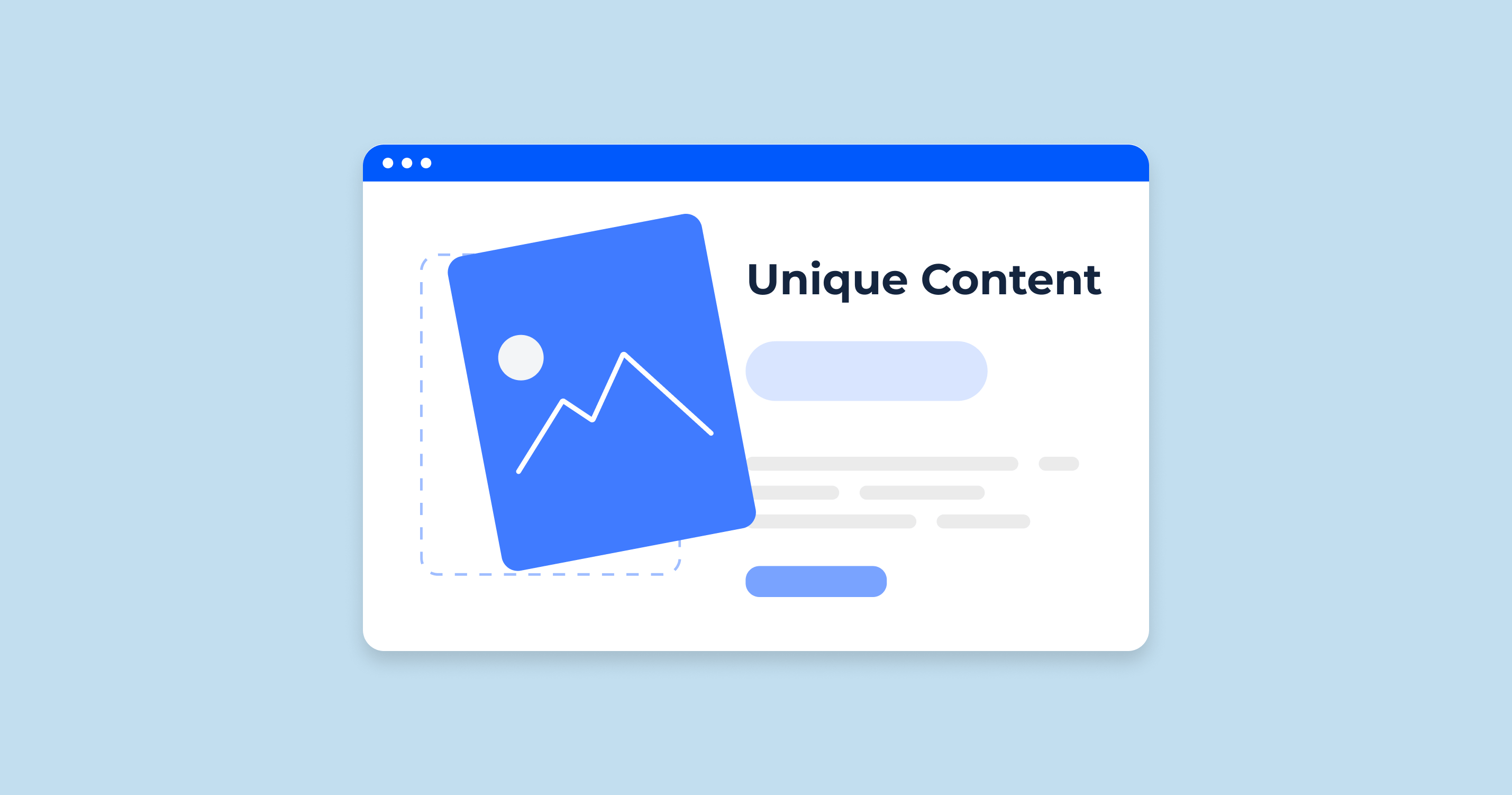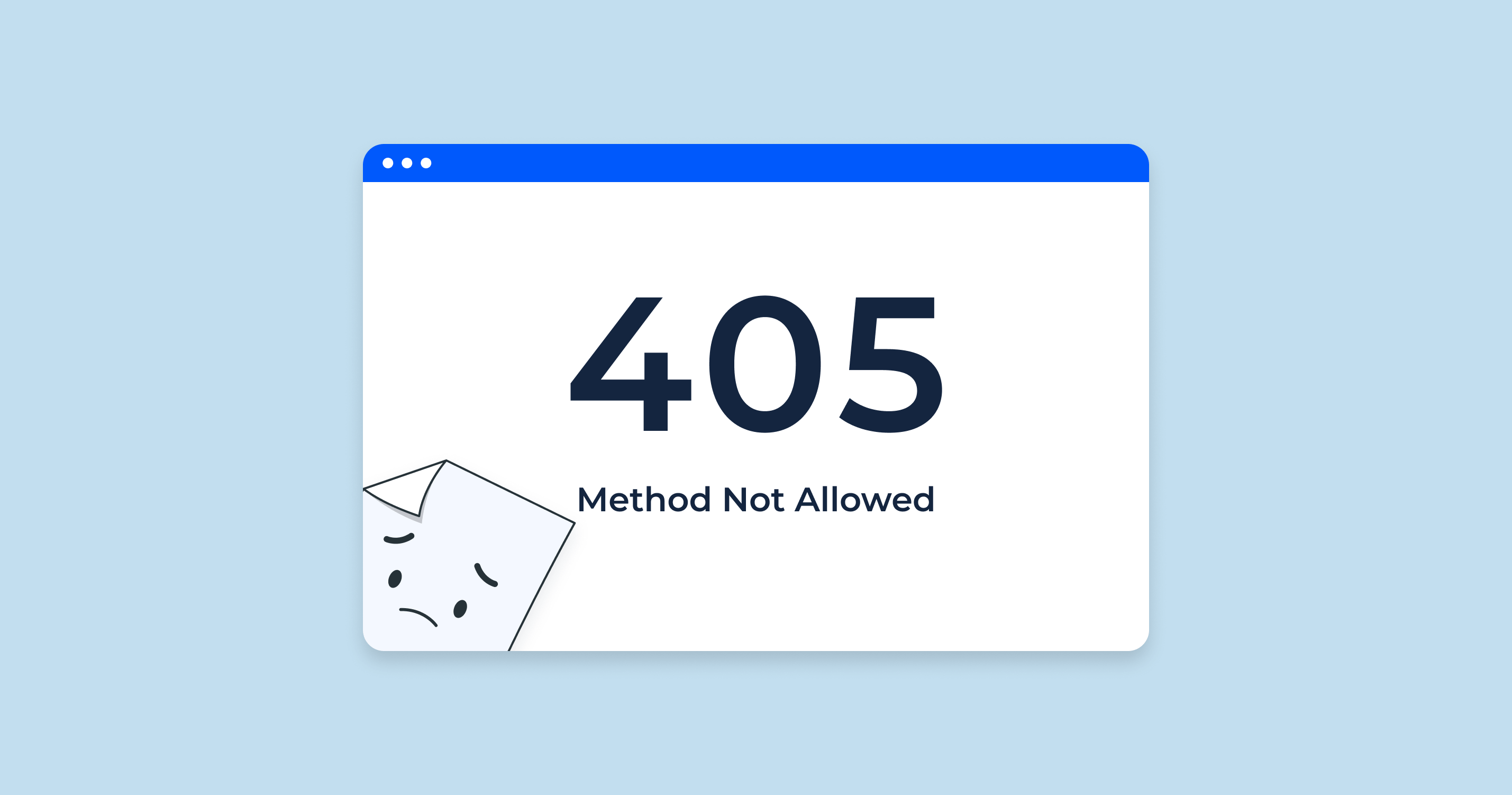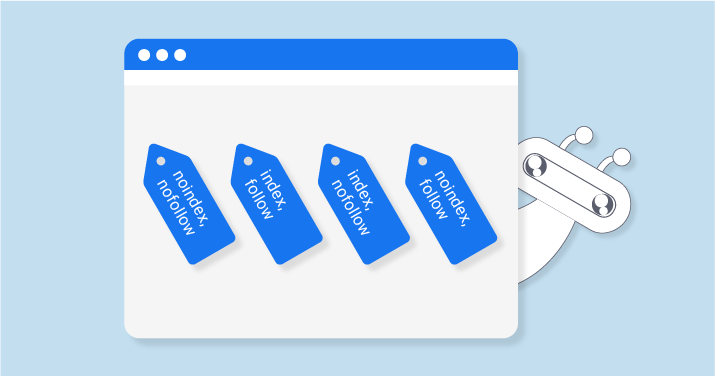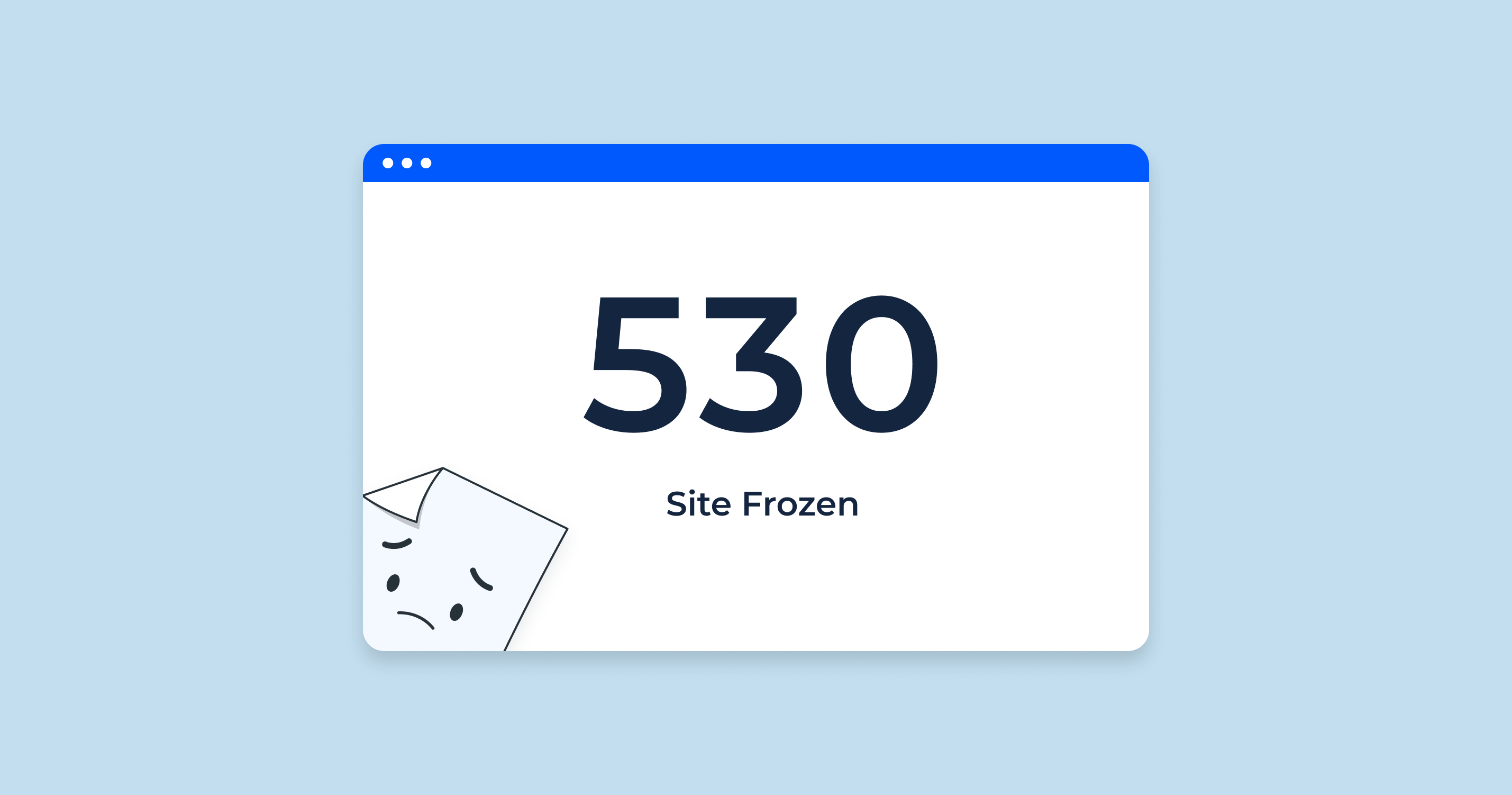What is Unique Content?
Unique content can be described as information presented in a manner that isn’t found elsewhere, especially on the internet. This uniqueness can manifest in various ways, from the way a topic is approached, the depth and breadth of the subject covered, to the originality of the perspective.
Definition of Unique Content
Unique content refers to original and distinct material, whether written, visual, or multimedia, that hasn’t been copied, republished, or reused from other sources without significant modification or rework. In the context of the web, it’s content that search engines haven’t indexed anywhere else. It isn’t just about avoiding plagiarism but creating something that adds value to the reader and stands out from the plethora of information available online.
Why Is Unique Content Important for Your Site and Search Engine Optimization?
| Enhanced User Experience | Readers come to websites looking for information, entertainment, or solutions to their problems. By providing unique content, you meet these needs more effectively and offer a perspective or solution they might not get elsewhere. |
| Improved Search Rankings | Search engines, particularly Google, reward unique content. When you provide content that isn’t found elsewhere, search engines are more likely to rank your page higher in the results, driving more organic traffic to your site. |
| Establishing Authority and Credibility | Regularly producing unique content positions your website or brand as an industry leader or an expert in the field. Over time, readers will turn to your site first because they trust the information you provide. |
| Boosting Engagement | Unique content is more likely to be shared, liked, and commented upon, increasing engagement levels on your site and across social media platforms. |
| Avoiding Duplicate Content Penalties | Search engines aim to deliver the best user experience, which means they try to avoid showing similar content from different websites. Sites with duplicate content can face ranking penalties. |
| Enhancing Brand Value | By offering something different from competitors, brands can differentiate themselves in the market, foster greater loyalty, and enhance their overall value proposition. |
In essence, unique content is a cornerstone of a successful online presence. Not only does it directly benefit SEO efforts, but it also plays a crucial role in brand building and establishing long-term connections with your audience.
Unique Content vs. Duplicate Content vs. Plagiarized
In the realm of content creation, it’s vital to understand the differences between unique, duplicate, and plagiarized content. While they might sound similar to the uninitiated, they have distinct characteristics and implications for both creators and website owners.
Unique (Original) Content
Unique or original content is material that is freshly created and not found elsewhere, especially on the internet. It represents a novel approach, perspective, or information on a particular topic.
Characteristics:
- Offers a fresh viewpoint or analysis.
- Hasn’t been copied or republished from other sources.
- Tailored for a specific audience, ensuring it adds value for them.
- Often stems from personal experiences, insights, research, or expertise.
Benefits:
- Boosts SEO by enhancing the website’s credibility and authority.
- Attracts and retains a loyal audience.
- Reduces the risk of incurring search engine penalties.
- Increases engagement and shareability on social platforms.
Duplicate Content
Duplicate content refers to blocks of content that are either completely identical or very similar, appearing in more than one location on the internet. This could be within the same website or across multiple sites.
Characteristics:
- Repetition of content across various web pages.
- Can be a result of URL variations, session IDs, or printer-friendly versions of web pages.
- Content copied from one site and republished on another without significant changes.
Implications:
- Search engines might struggle to decide which version of the content to index, which could hurt the visibility of all versions.
- Can lead to dilution of link equity if multiple versions of the content receive backlinks.
- Can result in a poor user experience as users might encounter the same content on multiple URLs.
Plagiarized Content
Plagiarism involves taking someone else’s work and presenting it as your own without their consent or without giving appropriate credit. In content terms, it’s copying and republishing material from another source without permission or acknowledgment.
Characteristics:
- Direct copying of content without attribution.
- Reusing content with minimal changes, such as simple rephrasing or thesaurus-based word substitutions.
- Often done without the original creator’s knowledge or permission.
Implications:
- Highly unethical and can lead to severe legal consequences.
- Damages the credibility and trustworthiness of the plagiarizing site.
- Search engines, especially Google, can penalize plagiarized content severely, making the site virtually invisible in search results.
- Hurts the original content creators, as their work is being used without compensation or credit.
Unique Content and SEO
Search Engine Optimization (SEO) is a set of strategies and tactics aimed at increasing a website’s visibility on search engine results pages. At the heart of these strategies lies content – the information, insights, and entertainment you provide to visitors. Unique content, in particular, plays a pivotal role in effective SEO. Let’s delve into why that is and how to leverage it.
Why Unique Content Matters for SEO:
- Higher Search Rankings: Search engines, with Google at the forefront, are designed to provide the best possible experience for users. To achieve this, they prioritize content that is fresh, relevant, and unique. Websites that consistently produce original content have a better chance of ranking higher in search results.
- Avoiding Penalties: Duplicate content can be problematic for search engines as they prefer not to show similar content from different sites. Websites with significant duplicate content can suffer from ranking demotions. Plagiarized content can lead to even more severe penalties, rendering a site virtually invisible in search results.
- Increasing Organic Traffic: Unique content, particularly when aligned with user intent and relevant keywords, can attract more organic traffic. When users find content that addresses their needs or questions in a way they haven’t seen elsewhere, they’re more likely to visit and revisit the site.
- Boosting Engagement Metrics: Original content tends to engage users more effectively, leading to longer time-on-page, lower bounce rates, and higher interaction rates, all of which can positively influence SEO.
- Link Building: Unique content is more likely to be cited or linked to by other websites, bloggers, and social media users. These backlinks are invaluable for SEO, serving as endorsements and boosting a website’s authority and credibility in the eyes of search engines.
- Enhancing Brand Authority: Regularly publishing original content positions a brand as a thought leader or expert in its niche. This not only improves organic visibility but also fosters trust with users, making them more likely to engage, convert, or become loyal customers.
Leveraging Unique Content for SEO:
- Keyword Integration: While ensuring your content is unique, it’s also essential to incorporate relevant keywords naturally. This makes it easier for search engines to understand the content’s context and rank it appropriately.
- Update Regularly: The internet is dynamic, and what’s considered unique today might become commonplace tomorrow. Regularly updating your content ensures it remains fresh and relevant.
- Quality Over Quantity: While it’s essential to publish regularly, it’s even more crucial to ensure the content is of high quality. Well-researched, well-structured, and insightful content will always outperform hastily put-together articles in the long run.
- Use Multimedia: Enhance your unique written content with original images, videos, infographics, and other multimedia elements. This not only boosts user engagement but can also improve your content’s visibility in diverse search results like Google Images or Video search.
- Promotion: Even the most unique content needs a nudge. Promote your content through social media, email marketing, and other channels to increase its reach and visibility.
Unique content isn’t just a recommendation; it’s a cornerstone of modern SEO. By understanding its significance and implementing strategies to consistently produce original content, websites can achieve better visibility, more organic traffic, and higher user engagement. H2 Unique Content and Social Media
How to Create Unique Content?
Crafting unique content requires more than just writing skills. It involves a blend of research, strategy, creativity, and execution. Below are some steps and tips to help guide the creation of original and compelling content.
Craft a Strong Headline
Your headline is the first impression readers have of your content. Make it count.
- Use powerful words that invoke emotion or curiosity.
- Keep it relevant to the content’s subject.
- Test multiple headlines to determine which one resonates the most with your target audience.
Create Persona for Content Marketing Strategy
Understanding your audience is pivotal.
- Develop detailed personas representing different segments of your audience.
- Consider their demographics, interests, challenges, and browsing habits.
- Tailor your content to address the needs and interests of these personas.
Keyword Research
Identify the terms your audience is using to find content.
- Use tools like Keyword Suggestion Tool for SEO
- Look for long-tail keywords that can guide detailed, niche topics.
- Ensure the keywords align with user intent.
Use Multiple Sources When Writing a Blog Article
Diversify your knowledge base.
- Refer to various credible sources to gather information.
- Cross-check facts and data.
- Bring together different viewpoints to offer a comprehensive view of the topic.
Make Your Content Scannable
Online readers often skim.
- Use subheadings, bullet points, and short paragraphs.
- Highlight key points or use pull quotes.
- Ensure a logical flow to guide readers through the content.
Ideation
Brainstorm topic ideas.
- Consider gaps in existing content.
- Use tools like BuzzSumo to identify trending topics.
- Gather team input and encourage creativity.
Add a Fresh Perspective
Stand out from the crowd.
- Challenge the status quo or popular opinions.
- Bring in expert opinions or interviews.
- Use real-world examples to illustrate points.
Set Up Content Calendar
Organize your content strategy.
- Plan topics and publishing dates ahead of time.
- Ensure a mix of content types and topics.
- Adjust based on performance metrics and feedback.
Include Personal Experience
Personal stories resonate.
- Share anecdotes or lessons learned.
- Relate personal experiences to broader topics.
- Ensure authenticity and sincerity.
Create Brief
Guide your content creation.
- Outline the main points and structure.
- Specify the target audience and content goals.
- Include keyword targets and any specific calls to action.
Start Writing Unique Content for Blog
Turn your plan into prose.
- Stay focused on the topic and user intent.
- Maintain a consistent tone and voice.
- Ensure clarity and coherence.
Edit the Draft & Check Unique Content
Refinement is key.
- Review for grammar, structure, and flow.
- Ensure originality using plagiarism checkers.
- Get feedback from peers or team members.
Promote Content
Maximize reach and visibility.
- Share across social media channels.
- Consider email marketing or newsletters.
- Engage with readers through comments or discussions.
By integrating these steps into your content creation process, you can consistently produce content that is not only unique but also resonates with your audience and serves their needs.
What Are the Common Mistakes People Make With Their Content and SEO?
Navigating the intricacies of content and SEO can be challenging. While many understand the basics, they sometimes overlook critical aspects, leading to mistakes that can impact their online visibility and engagement. Here’s a breakdown of common pitfalls and how to avoid them.
Creating Duplicate Content
- What it is: Publishing identical or substantially similar content on multiple pages or websites.
- Why it’s problematic: Search engines might not know which version to rank, potentially leading to decreased visibility. It can also dilute link equity.
- Solution: Use canonical tags to indicate preferred content, re-write similar content to make it unique, and avoid unnecessary URL variations.
Not Using Keywords Strategically
- What it is: Overlooking the integration of relevant keywords or stuffing content with them excessively.
- Why it’s problematic: Without strategic keyword use, content might not align with search intent, reducing its visibility. Keyword stuffing can lead to penalties.
- Solution: Conduct thorough keyword research and naturally integrate them into the content. Focus on user intent.
Not Creating Enough Content
- What it is: Inconsistent or infrequent content publishing.
- Why it’s problematic: It can reduce website authority, hurt SEO rankings, and give competitors an edge.
- Solution: Develop a content calendar and maintain consistency. Quality should always come before quantity, but regular updates are essential.
Having Plagiarized Content
- What it is: Copying content from other sources without permission or proper attribution.
- Why it’s problematic: It’s unethical, can lead to legal issues, and search engines can penalize plagiarized content heavily.
- Solution: Always create original content. If borrowing ideas or quotes, always give proper credit.
Not Determining the Goal of Each Blog
- What it is: Writing content without a clear purpose or objective.
- Why it’s problematic: Content without a clear goal might not meet the needs or expectations of the audience, leading to decreased engagement and conversions.
- Solution: Before writing, define the purpose of the content, whether it’s to inform, entertain, persuade, or convert.
Not Updating the Old Content
- What it is: Leaving outdated information, data, or practices on your website without updates.
- Why it’s problematic: Outdated content can misinform users, reduce trust, and diminish SEO value as search engines prioritize fresh, relevant content.
- Solution: Regularly review and update old content. Consider adding new data, insights, or examples to keep it relevant.
Tools for Exploring Unique Content Ideas
In the ever-evolving digital landscape, staying ahead of the content curve is crucial. But generating unique content ideas isn’t always easy. Thankfully, several tools can help creators identify trends, understand audience needs, and derive inspiration. One such indispensable tool is Google Trends.
- What it is: Google Trends is a free online tool provided by Google that displays how often specific search terms are entered relative to the site’s total search volume over a given period.
-
Benefits:
- Trend Analysis: See the popularity of search queries over time. This can help identify seasonal trends or emerging topics.
- Regional Breakdown: Discover where specific search terms are most popular, which can be invaluable for targeting content geographically.
- Related Queries: Unearth search terms related to the original query, offering additional angles or related topics for content creation.
- Compare Terms: Compare the search volumes of two or more terms to identify which is more popular or to understand their relative significance.
- Real-time Data: During significant global events or trends, Google Trends can offer real-time data on what people are searching, allowing for timely content creation.
-
How to Use:
- Visit the Google Trends website.
- Enter a search term or topic in the search box.
-
Adjust the region, time range, and other settings as needed.
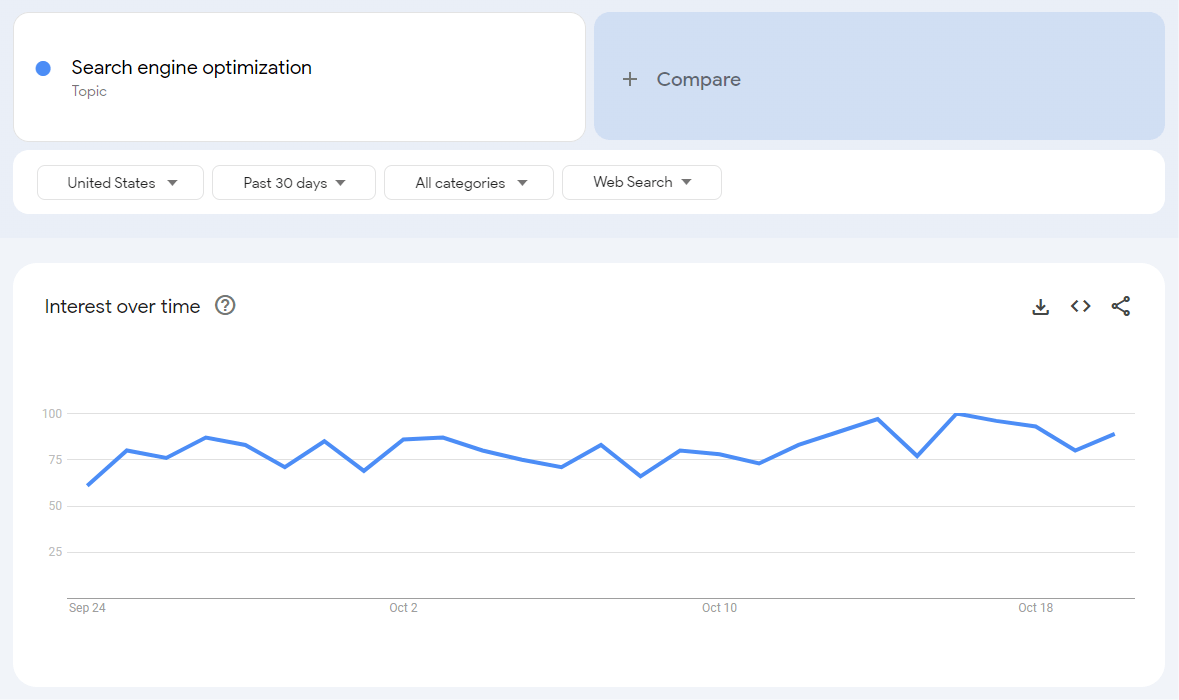
- Analyze the data, look for patterns, spikes, or declines in interest.
-
Explore related queries and topics for additional insights.
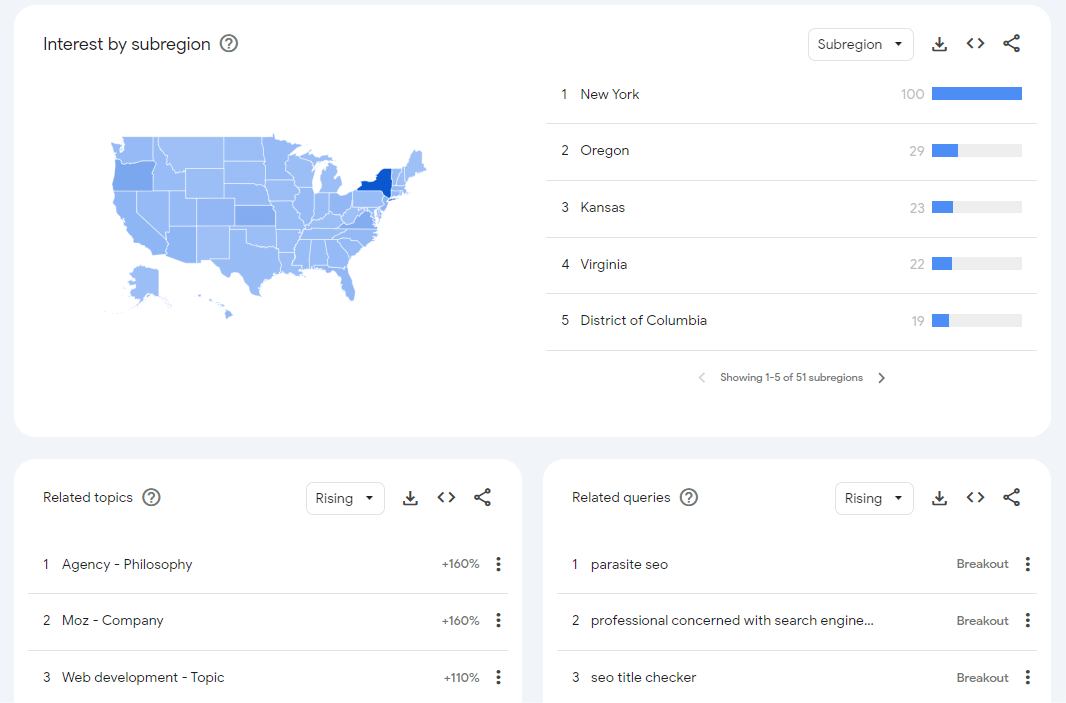
-
Application for Content Creation:
- Content Relevance: By tracking trending topics in real-time, you can produce content that is timely and relevant to current global or local events.
- Niche Exploration: Identify topics that are gaining traction but might not be overly saturated, offering opportunities for niche content.
- Audience Understanding: By understanding what people are searching for, you can better tailor your content to meet the needs and interests of your target audience.
Editorial Tools
As the digital age evolves, so does the importance of polished, well-edited content. From blog posts to professional reports, clarity and correctness are key. To assist writers in producing high-quality content, several editorial tools have emerged. Three of the most notable tools are Grammarly, Hemingway Editor and the Editpad.
Grammarly
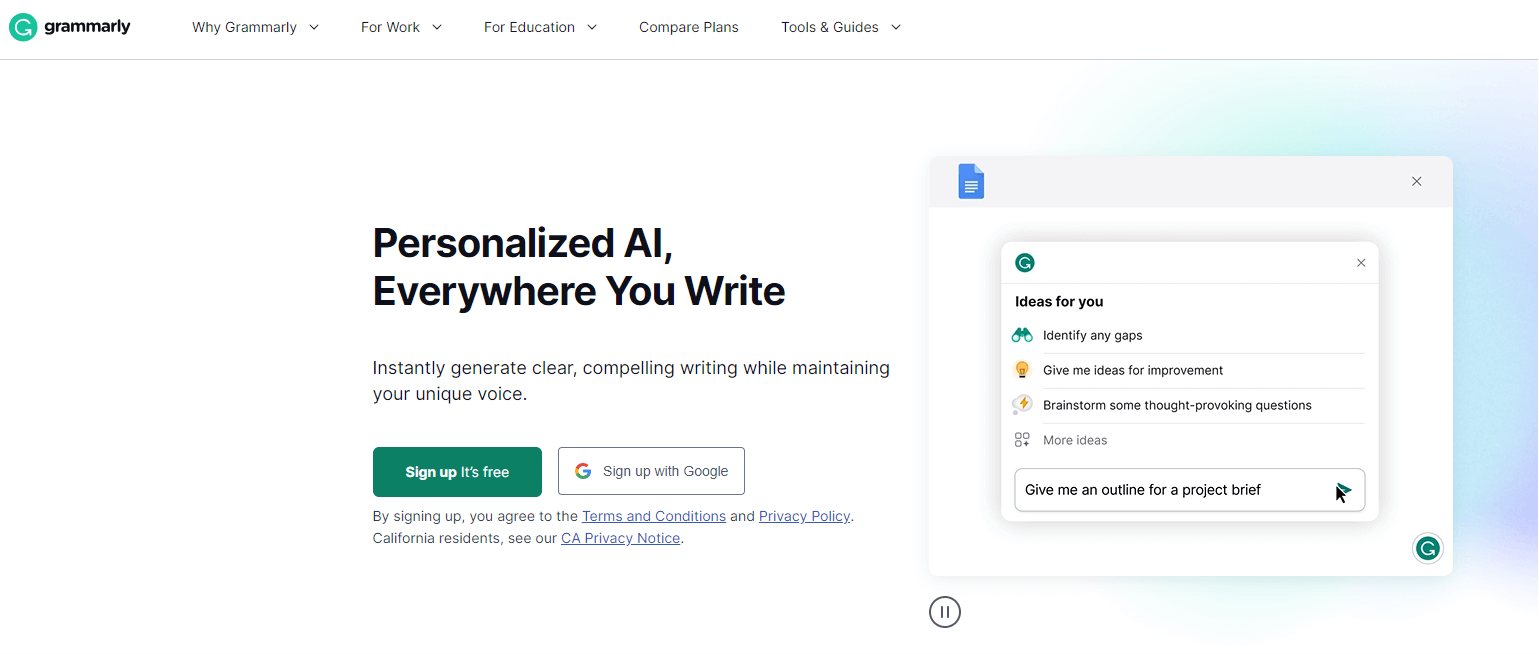
What it is: Grammarly is an AI-powered writing assistant that helps users correct grammatical mistakes, enhance clarity, and refine the overall tone of their content.
Features:
- Spelling & Grammar Check: Automatically detects and corrects spelling, punctuation, and grammar errors.
- Tone Detector: Analyzes the text to provide feedback on the overall tone, from confident and friendly to formal or concerned.
- Clarity Suggestions: Offers suggestions to make sentences clearer and more concise.
- Plagiarism Detector: Checks the content against billions of web pages to ensure originality.
- Personal Dictionary: Customize by adding words so that they aren’t flagged as mistakes.
How to Use:
- Install the Grammarly browser extension or use the web platform.
- Begin writing or paste your content into the editor.
- Review and apply the suggestions provided by Grammarly.
Benefits for Writers:
- Enhanced Accuracy: Helps writers avoid common and advanced writing mistakes.
- Improved Clarity: Assists in crafting more understandable and engaging content.
- Confidence in Originality: Reduces worries about unintentional plagiarism.
Hemingway Editor
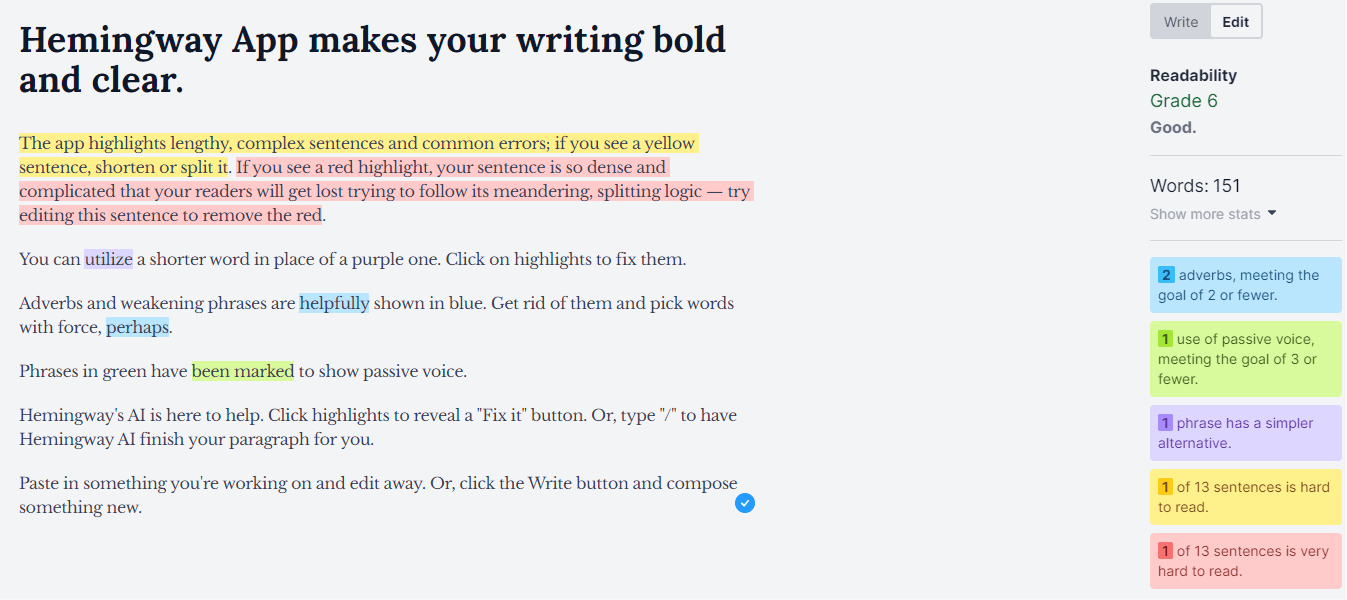
What it is: The Hemingway Editor is an online and offline writing tool designed to improve the readability of content. It highlights complex sentences, adverb overuse, passive voice, and other common pitfalls.
Features:
- Readability Grade: Assigns a readability grade level to your content, indicating the education level required to understand it.
- Sentence Complexity: Highlights hard-to-read sentences, urging writers to simplify or split them.
- Adverb Counter: Pinpoints overused adverbs that can often be eliminated for stronger prose.
Passive Voice Detector: Indicates instances of passive voice, suggesting an active voice alternative.
How to Use:
- Visit the Hemingway Editor website or use the desktop application.
- Paste your content into the editor.
- Review the color-coded highlights and consider the provided suggestions.
Benefits for Writers:
- Streamlined Writing: Encourages clear, bold writing by identifying areas of potential improvement.
- Immediate Feedback: Provides instant insights into the strength and clarity of content.
- Targeted Audience Writing: With the readability grade, writers can ensure their content aligns with their intended audience’s comprehension level.
Editpad
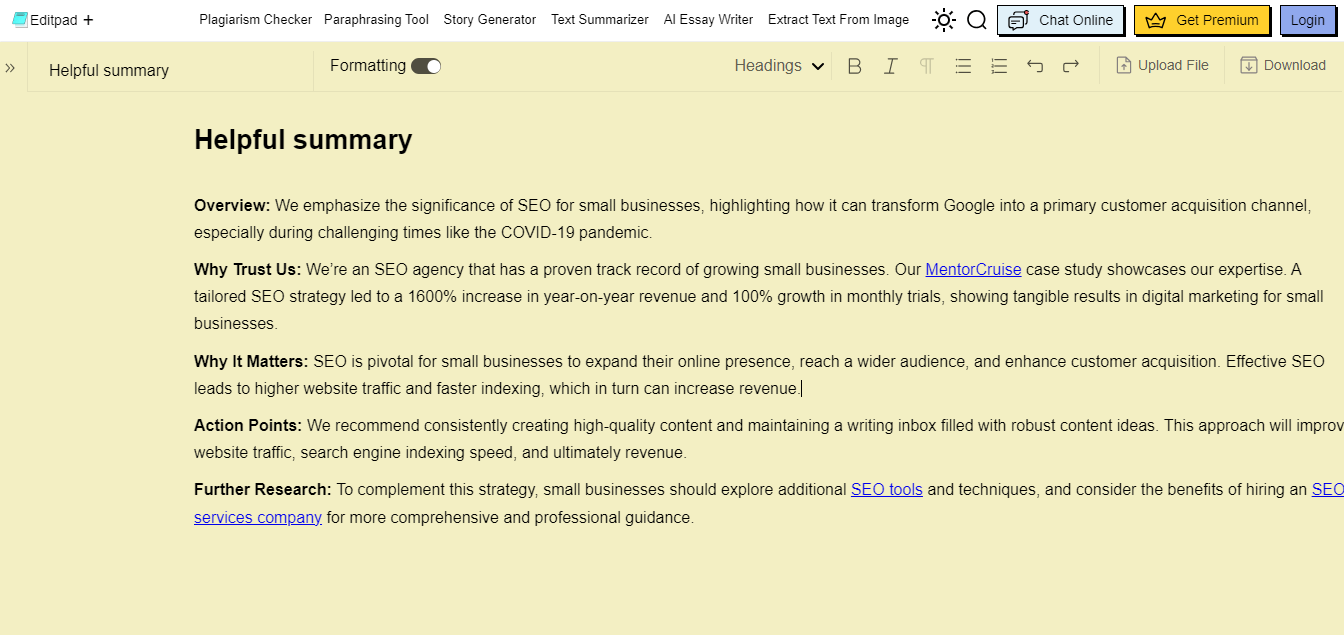
What is it: Editpad is a freemium toolkit offering numerous writing and editing tools that can help you come up with quality content. However, its main functionality is to assist users in editing and formatting content online.
Features:
- Text Editor: Quickly write, edit, format, and save content within the browser.
- Unique Paragraph Generation: Create 100% unique and compelling paragraphs on any topic using its AI paragraph generator.
- Elevate Content Quality: Automatically uplift the quality of the content in terms of uniqueness and clarity using the paraphrasing capabilities of Editpad.
- Grammar Perfection: Effortlessly find and correct all types of grammatical mistakes in your content for better quality.
How to Use:
- Visit the Editpad.org website.
- You will land on the text editor by default.
- Paste your content and start editing.
- You can also explore other AI writing tools as per your specific needs and requirements.
Benefits for Writers:
- Versatility: A comprehensive suite of tools, including text editing, paraphrasing, and plagiarism checking, all in one place.
- Improved Engagement: With the availability of different writing tools, writers can ensure the highest content quality which will ultimately provide a boost to user engagement.
- Time-Saving: Simplifies the editing and rewriting process with multiple integrated tools.
Tools for Visual Content Creation
In today’s digital age, compelling visual content is as crucial as the written word. With the rise of social media and multimedia platforms, engaging visuals can amplify a brand’s message and captivate audiences. Here are some leading tools that facilitate the creation of eye-catching visual content.
Canva

- What it is: Canva is a user-friendly graphic design platform that allows users to create a wide range of visuals, from social media graphics to presentations, without needing advanced design skills.
-
Features:
- Templates: Offers a plethora of pre-designed templates for various content types, sizes, and platforms.
- Drag-and-Drop Editor: Easily add elements, adjust colors, and rearrange items.
- Library: Access to a vast collection of images, fonts, and icons.
-
Benefits for Creators:
- Versatility: Suitable for both beginners and design-savvy users.
- Cost-Effective: Many features are available for free, with premium options available for advanced needs.
Giphy

- What it is: Giphy is a platform and search engine for discovering and sharing animated GIFs.
-
Features:
- GIF Maker: Create GIFs from videos, YouTube links, or other GIFs.
- Sticker Maker: Design and share your animated stickers.
- Library: Access to a vast collection of user-uploaded GIFs.
-
Benefits for Creators:
- Engagement: GIFs can make content more relatable and engaging, especially on social media.
- Simplicity: Easy-to-use tools for quick GIF creation and sharing.
Ceros – for Infographics

- What it is: Ceros is a platform designed for creating interactive and immersive digital content like infographics, e-magazines, and more.
-
Features:
- Templates: Provides pre-designed templates specifically for infographics and other content types.
- Interactivity: Add animations, embedded videos, and other interactive elements to your content.
- Collaboration: Work in real-time with teammates on content creation.
-
Benefits for Creators:
- Professional Quality: Produce high-end visuals and infographics with ease.
- Engaging Content: By adding interactive elements, content becomes more engaging for readers.
Don’t Forget About Visuals
- What it means: Beyond the specific tools mentioned, the overarching theme is the importance of integrating visuals into content strategy.
-
Key Takeaways:
- Retention: Visual content, whether images, GIFs, or infographics, helps in better retention of information by the audience.
- Shareability: Visually appealing content often gets shared more on social platforms, amplifying reach.
- Comprehension: Visuals can simplify complex information, making it more digestible for readers.
Embracing these tools and the power of visual content will undoubtedly elevate the appeal and impact of any digital content strategy. Whether you’re crafting a blog post, social media update, or presentation, remember: a picture (or GIF, or infographic) is worth a thousand words.
Unique Content Checker Tools
The Duplicate Content Checker by SiteChecker provides users with an efficient way to identify and address potentially detrimental duplicated content on their website. By simply entering a URL, users can quickly scan and get insights on content similarities, ensuring their site remains unique and avoids potential SEO pitfalls associated with content repetition.
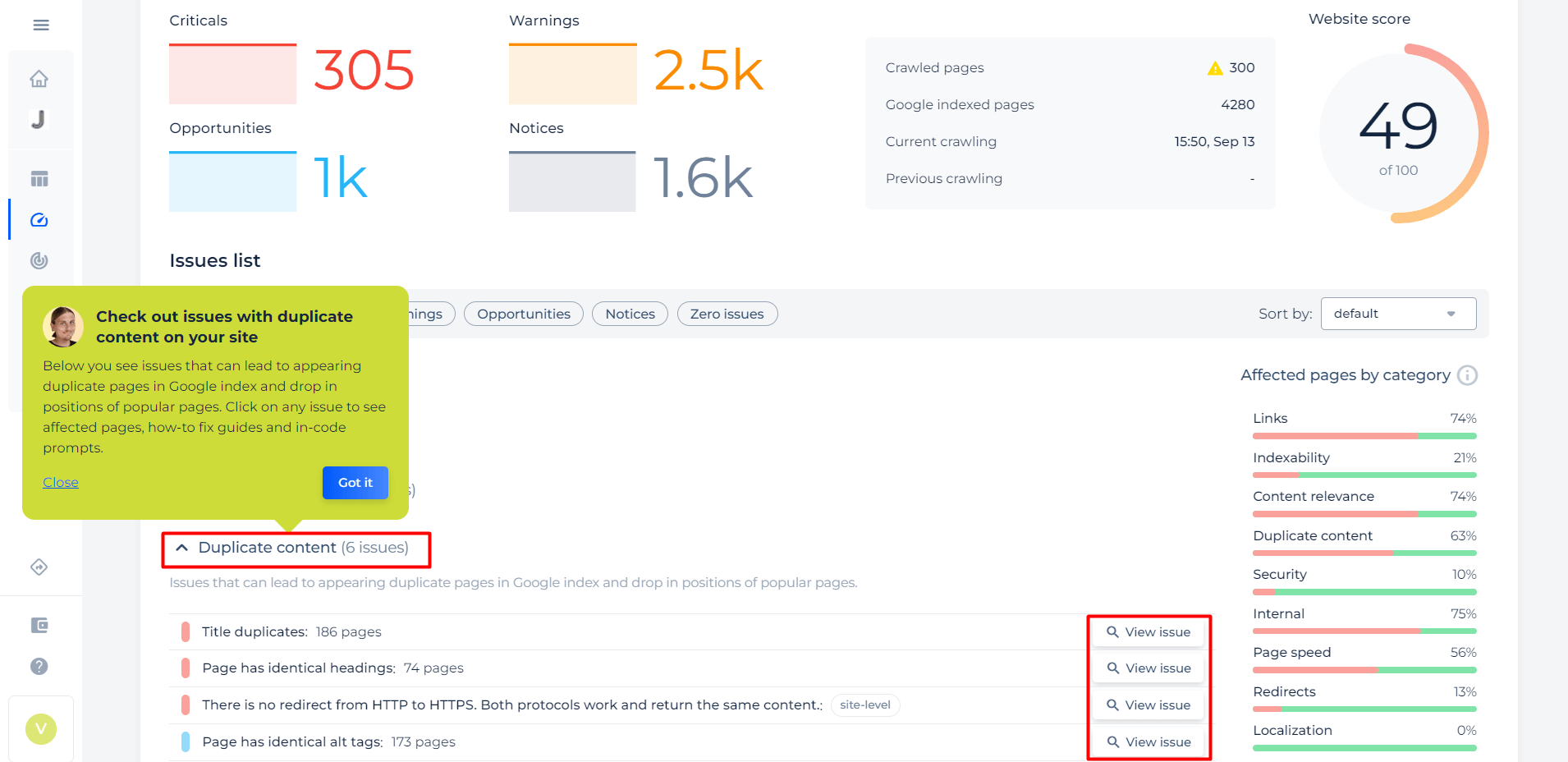
Beyond its core functionality, the tool stands out by also offering a visual representation of similar content and the option to check for external duplication. This means not only can you identify internal repetitions, but you can also ensure your content hasn’t been replicated on other external sites, guarding your site’s authenticity and credibility.
Ensure Your Content's Originality!
Spot potential content duplicates with our tool before search engines do.
How to Measure the Success of Your Content and SEO Efforts?
Successfully implementing content and SEO strategies requires consistent monitoring and analysis of key metrics. By tracking these metrics, content creators and marketers can gauge the effectiveness of their strategies and make necessary adjustments. Here are some crucial metrics to consider:
Website Traffic
What it is: The number of visitors that come to your website over a specific period.
Why it’s important:
- Reflects the overall visibility of your website in search results.
- Indicates the success of your promotional efforts and content reach.
How to measure:
- Use tools like Google Analytics or similar platforms.
- Monitor both unique visitors (first-time visitors) and returning visitors to gauge audience loyalty.
Tips:
- To increase website traffic, optimize your content for search engines, engage in content promotion, and use social media effectively.
Time-On Page
What it is: The average amount of time a visitor spends viewing a specific webpage.
Why it’s important:
- Indicates the quality and relevance of your content to the audience.
- Longer time-on-page often suggests that visitors find the content valuable and engaging.
How to measure:
- Platforms like Google Analytics provide insights into the average time-on-page for each of your webpages.
Tips:
- To improve time-on-page, ensure that your content is well-structured, engaging, and offers value to the reader. Incorporate multimedia elements, such as images or videos, to make the content more interactive.
Bounce Rate
What it is: The percentage of visitors who navigate away from the site after viewing only one page.
Why it’s important:
- A high bounce rate might indicate that visitors didn’t find what they were looking for or that the webpage wasn’t user-friendly.
- It helps in understanding user behavior and potential content or technical issues on the site.
How to measure:
- Tools like Google Analytics provide data on bounce rates for your entire site and individual pages.
Tips:
- To reduce bounce rate, ensure that your webpages load quickly, are mobile-optimized, and have clear calls to action. Also, provide relevant internal links to keep users engaged and navigating through more of your content.
Understanding and acting upon these metrics can provide invaluable insights into the success of your content and SEO strategies. Continuous monitoring and adjustments based on these data points will lead to improved audience engagement and better search engine rankings.
Unique Website Visitors
In the context of website analytics and digital marketing, understanding the different types of website visitors is critical. Among them, ‘Unique Website Visitors’ holds a special significance.
Definition
What it is: Unique Website Visitors refers to individuals who visit a website at least once within a specific period, typically tracked using cookies or IP addresses.
Why it’s different from ‘total visits’:
- One individual can generate multiple visits to a website, but they’ll only be counted as one unique visitor for that time period.
Significance
Why it’s important:
- Gauging Popularity: A high number of unique visitors indicates that your website is attracting a diverse audience.
- Marketing Insights: By knowing the number of unique visitors, marketers can better understand the potential reach of their campaigns.
- Conversion Analysis: When compared with total sales or leads, unique visitors help in calculating conversion rates.
How to Measure
Tools & Platforms:
- Google Analytics: This free tool by Google provides a comprehensive breakdown of your website traffic, including unique visitors.
- Similar Web, SEMrush, Ahrefs: These platforms offer insights into your website’s unique visitors among other analytics.
Metrics:
- Typically displayed as “Users” in Google Analytics.
- Can be filtered by date range, demographic details, and traffic source to get more granular insights.
Enhancing Unique Visitors
Strategies to increase unique visitors:
- Content Marketing: Regularly publishing high-quality, relevant content attracts a broader audience over time.
- Social Media Promotion: Sharing your content across various social media platforms can help tap into new audience segments.
- Search Engine Optimization (SEO): Ensure that your website is optimized for search engines to attract organic traffic.
- Paid Advertising: Platforms like Google Ads or social media ads can bring in a surge of new visitors when done right.
Want to Improve Your Content?
Content is the backbone of digital marketing, and with the online space becoming increasingly competitive, it’s imperative to continually refine and elevate your content game. Here are some advanced insights and tactics to enhance your content and make it stand out.
Understand Your Audience Deeply
Incorporating AI-driven content solutions like a Paraphrasing tool can significantly boost the uniqueness and quality of your site’s material. While unique content is essential for staying clear of duplicate inputs and plagiarism pitfalls, utilizing tools that offer full-length paraphrasing can breathe new life into existing texts. This not only aids in maintaining originality but also enhances readability by reworking outdated phrasing, expanding vocabulary, and improving the text’s quality without sacrificing substance
What it means: Go beyond demographics. Understand their pain points, preferences, and motivations.
Action Steps:
- Use audience persona templates to create detailed profiles.
- Conduct surveys or interviews to get direct insights.
Incorporate Data and Research
Importance:
- Adds credibility to your claims.
- Makes your content more compelling and authoritative.
Action Steps:
- Use reputable sources.
- Incorporate charts, graphs, or infographics for better visualization.
Diversify Your Content Types
Why it matters:
- Different audience segments prefer different content types.
- Helps in tapping into varied traffic sources.
Action Steps:
- Incorporate videos, podcasts, webinars, etc.
- Repurpose blog content into other formats to maximize reach.
Storytelling and Relatability
Significance:
- Stories are memorable and can make your content resonate more with your audience.
- It fosters a deeper connection with readers.
Action Steps:
- Use real-life examples or case studies.
- Incorporate narratives in your content strategy.
Collaborate with Influencers or Industry Experts
Benefits:
- Boosts your content’s reach and credibility.
- Attracts a new set of audience from the collaborator’s followers.
Action Steps:
- Host joint webinars or podcasts.
- Collaborate on creating in-depth guides or eBooks.
Continuous Learning and Adaptation
Why it’s vital:
- The content landscape is ever-evolving.
- To stay ahead, continuous learning is crucial.
Action Steps:
- Attend content marketing workshops or webinars.
- Stay updated with industry blogs or newsletters.
A/B Testing and Data-Driven Decisions
Essence:
- Understand what truly works for your audience.
- Make decisions based on actual data rather than assumptions.
Action Steps:
- Test different headlines, content formats, or promotional strategies.
Improving content is not a one-time task but a continuous effort. By keeping abreast of the latest trends, understanding your audience better, and being willing to innovate and adapt, you can ensure that your content remains relevant, engaging, and impactful.
Conclusion
In the ever-evolving digital landscape, the significance of unique and impactful content cannot be overstated. It serves as the bedrock for online engagements, dictating the success of digital marketing endeavors and the overall online presence of businesses and individuals alike. As we’ve explored, from understanding unique content to the tools and strategies to create and optimize it, the journey requires continuous effort and learning. It’s crucial to remember that, in this vast digital expanse, content that resonates, provides value, and is original will always find its audience.
Staying true to these principles, while keeping a finger on the pulse of changing trends, will ensure that your content efforts yield the desired outcomes. Embrace the journey, for in the realm of content, the pursuit of excellence is both the challenge and the reward.
